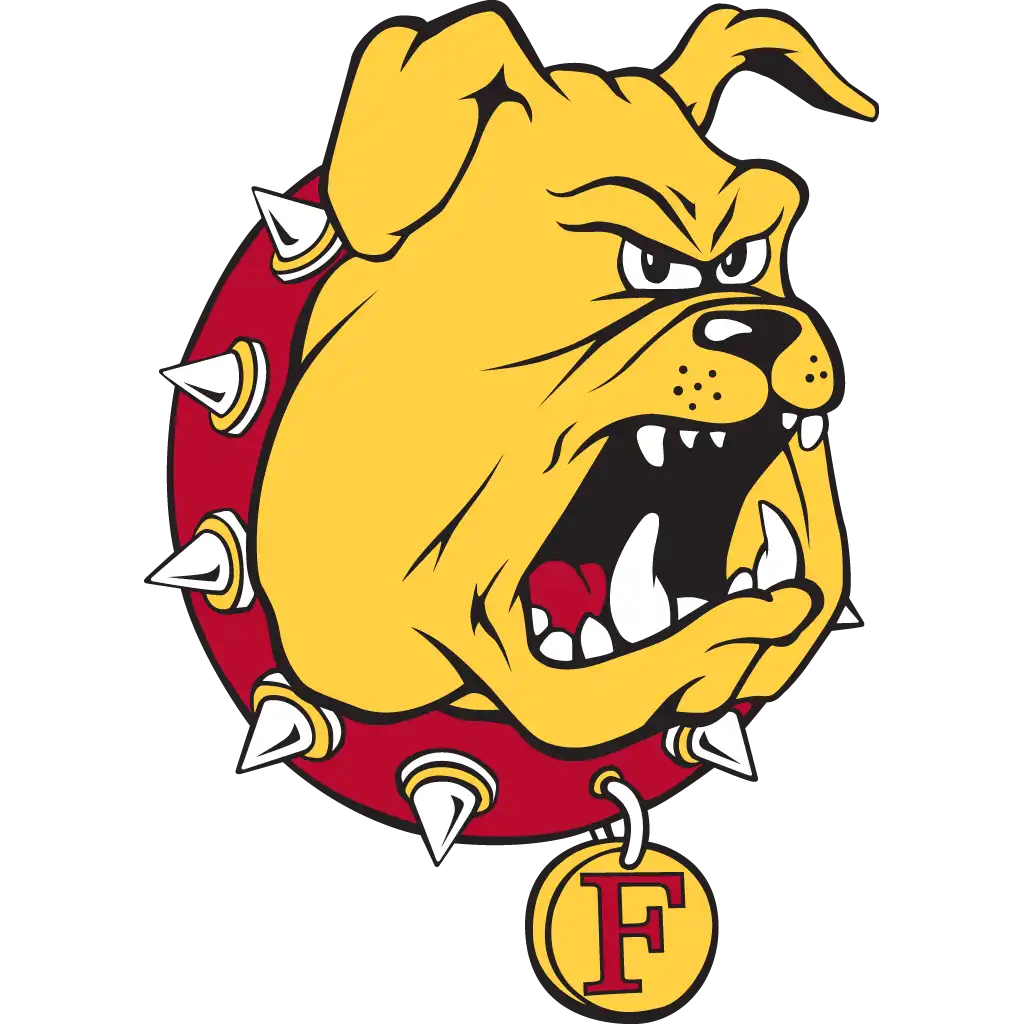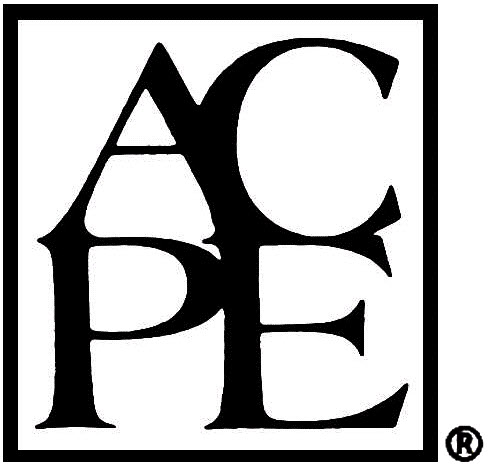220 Ferris Drive
Rm. 201
Big Rapids, MI 49307
(231) 591-2252
Founded in the city of Big Rapids, Michigan, by Woodbridge N. Ferris, Ferris State University, then known as the Big Rapids Industrial School, but soon to be called the Ferris Industrial School, first opened its doors for admission in September 1884. Occupying the second floor of one of the downtown store buildings, the school first enrolled 15 students in that first class. The time, Mr. Ferris focused the school on serving as a source of industrial, commercial, English, and teaching training. His primary objective was to provide individuals who had failed to gain adequate elementary or secondary education with suitable skills to improve their stations in life. Hence, the first course offerings were in the area of business and secretarial skills, that is, accounting, penmanship, shorthand, grammar, etc. When requests for a new course were sufficient to justify it, the course was added to the curriculum. It was just such a demand that led the founding of the College of Pharmacy.
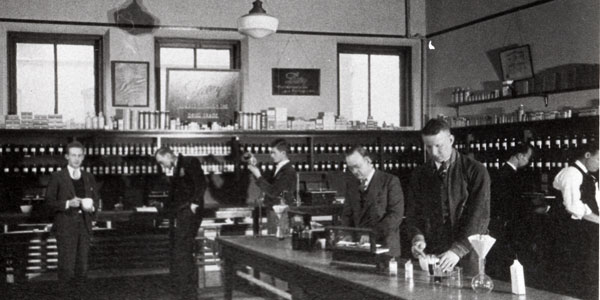
In 1893, young Marius Preysz of Barryton, Michigan, asked for training in the subject of pharmacy in order to prepare himself for the state board examination. According to the regulations of the Michigan State Board of Pharmacy at that time, candidates for examination as registered pharmacists were required to have at least three years actual experience in compounding drugs in a retail drug store under the supervision of a registered pharmacist. Applicants could, however, submit evidence of work in the Department of Pharmacy of an accredited school in lieu of a portion of the required practical experience. Up to two years of credit were allowed, nine months of school work being considered equivalent to one year of practical experience. Although Mr. Ferris was not trained in pharmacy, the fact that he had been a student for one year in the Medical Department of the University of Michigan aided him greatly in his task of preparing Mr. Preysz. Mr. Ferris purchased a handbook covering the subjects required by the state board and proceeded to give Mr. Preysz the necessary instruction. It was the successful execution of this venture, along with similar success achieved in tutoring others who followed in the footsteps of Mr. Preysz, which encouraged Mr. Ferris to establish the Department of Pharmacy as a separate entity in the Ferris Industrial School.
A one-year preparatory course in pharmacy consisting of three quarters of four months duration each was offered in the 1894 catalogue of the Ferris Industrial School. This program was apparently under the direction of Mr. Will D. Henderson, a former student at the school who later became a well-known author and professor of physics at the University of Michigan. The course was, in most respects, identical with the first year of work outlined by the School of Pharmacy of the University of Michigan, and, by arrangement with the faculty of that school, students who had completed one year of work in the Department of Pharmacy at the Ferris Industrial School were permitted to enter the second year at the University of Michigan School of Pharmacy.
It was at this time that enrollment, having exceeded the capacity of the rented quarters in downtown Big Rapids, necessitated the construction of a new building to accommodate the rapidly increasing enrollment. The building, completed and occupied in 1894, was familiarly known as Old Main and was located at the site of the present campus until destroyed by fire in 1950, along with the three-story pharmacy addition constructed in 1901.
When Mr. Henderson resigned in 1900 to pursue further study, he was succeeded by Mr. J.A. Hynes as head of the Department of Pharmacy. Two significant events that must be noted occurred at this time. The name of the school was changed from the Ferris Industrial School to Ferris Institute and the First-year College Department was organized. It was this latter event that provided the necessary foundation for the establishment of a two-year course of study in pharmacy. Mr. Hynes successfully inaugurated this program, graduating the first two-year class in 1903. It is apparent that not all students, or even most of them, availed themselves of the benefits of the program. Many students with previous drugstore experience attended only long enough to ensure success in the state board examination. The school itself continued for several years to offer a short course in pharmacy for those individuals who specifically sought preparation for the state board examination.
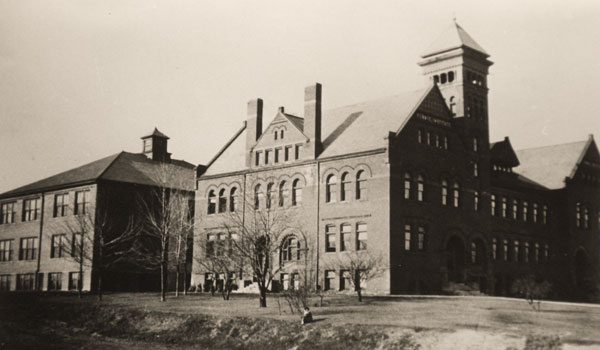
Few major changes were to be made in pharmaceutical education over the next 20 years, and the Ferris Institute Department of Pharmacy continued to grow rapidly under the leadership of William A. Peterson (1903-06), Charles L. Pickell (1906-11), Ernest J. Parr (1911-19), and M.A. Jones (1919-24). The quality of the program and the success of its graduates attracted students throughout the state, and by 1916, over 150 students were being enrolled annually in both the long and the short courses of pharmacy and more than 1,000 students in the entire institution. This phenomenal growth can, at least in part, be attributed to the widespread publicity the school enjoyed as a result of Mr. Ferris political activities. An unsuccessful candidate for the governorship of Michigan in 1904, Mr. Ferris won election to that office in 1912 and reelection in 1914. Following a losing bid for a third term as governor of Michigan in 1920, he was elected in 1922 to the United States Senate, an office he held until his death in 1928.
The reappointment of Mr. Parr as dean of Pharmacy in 1924 heralded a decade of significant changes in pharmacy education at Ferris. Legislative action in 1925 made two years of study in an accredited school or college of pharmacy a mandatory requirement for licensure after January 1, 1929, in the state of Michigan. At the same time, a national trend toward increasing the academic requirements for pharmaceutical education influenced the thinking of educators throughout the country. In keeping with the times, Dean Parr initiated a three-year pharmacy program which consisted primarily of a year of advanced courses appended to the two-year curriculum. The degree of Pharmaceutical Graduate (Ph.G.) was to be awarded to graduates of this extended program. Although first offered in 1927, there appear to have been no students electing this program until 1930, when three young men completed the third year and were granted the Ph.G. degree. Subsequent graduates of this program were awarded the degree of Pharmaceutical Chemist (Ph.C.).
With the passing of both Senator Ferris in 1928 and his successor, Gerrit Masselink, in 1929, the school faced one of the greatest crises of its history. It became obvious that reorganization was necessary in order to guarantee the survival of the institution. In 1931, the school passed from a privately owned corporation to a non-profit educational institution, operated by a board of trustees who served without pay.
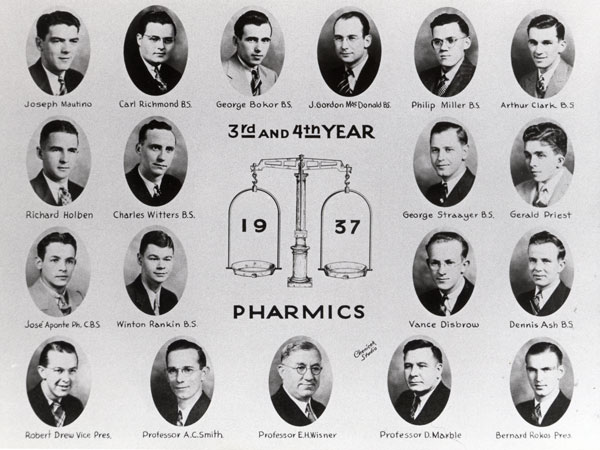
Dean Parr, whose dedication to pharmaceutical education had already given the Ferris Institute Department of Pharmacy a reputation for excellence, again paved the way in 1932 for the inauguration of the four-year curriculum leading to the degree of Bachelor of Science in Pharmacy. In the spring of following year, the newly designated College of Pharmacy granted this degree for the first time at Ferris to four members of the graduating class. This was indeed an unusual graduation ceremony since, in addition to the four graduates receiving their degree of Bachelor of Science in Pharmacy, several young men and women received either the degree of Pharmaceutical Chemist or a Diploma in Pharmacy, depending upon the length of their curriculum. This anomaly, however, was not to exist for long. The four-year program became the minimum requirement for graduates for all students entering the College of Pharmacy in 1936, and all other shorter courses were withdrawn from the catalogue in 1937.
Dean Parr accepted an appointment in 1933 as director of drugs and drugstores for the State of Michigan, and it was through the efforts of his able successor, Dean Eber H. Wisner (1933-37), that the College of Pharmacy gained membership in the American Association of Colleges of Pharmacy in 1938. Dean Simon Benson (1937-41), appointed to that office upon the untimely death of Dean Wisner, petitioned for full accreditation of the College of Pharmacy by the American Council on Pharmaceutical Education, and accreditation was granted by that organization on December 1, 1939.
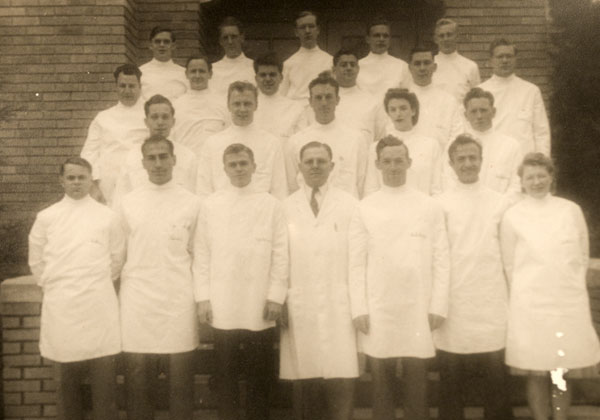
Dean Howard Hopkins, succeeding Dean Benson in 1941, faced one of the most trying times in the history of the school. World War II depleted the enrollment to less than 50 students in the entire institution and brought on an era of extreme financial difficulties. In addition, the formation of a pharmacy program at the University of Grand Rapids that was headed by former Ferris Dean Parr not only successfully competed for students, but also attracted several Ferris faculty. Hope for recovery must have appeared dim to Mr. Ralph Wilson (1944-56) when he assumed the duties of the dean of pharmacy in 1944. However, with the cessation of hostilities the following year and the influx of veterans under the GI Bill® of Rights, enrollment returned to normal and the crisis was somewhat relieved.
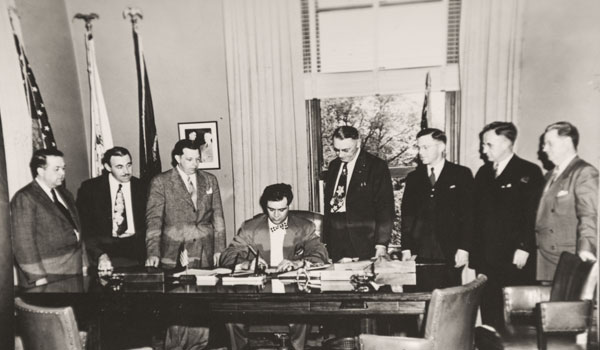
The problems created by the war years were not entirely solved. The pressure of the indebtedness incurred during this period, as well as the general feeling that the institution could and did fill an important need to Michigan higher education prompted the board of trustees to offer Ferris Institute to the state of Michigan as a memorial to the late Senator Ferris. The Smith-VanderWerp Bill (Act 114, Michigan Public Acts of 1949) passed both houses of the state legislature and was signed by Governor G. Mennen Williams on May 17, 1949. This act made Ferris Institute a state college, effective July 1, 1950. On February 21, 1950, shortly before the state was to assume control, a devastating fire destroyed the Main Building and the Pharmacy Building, including the entire college library. Only Alumni Hall and the temporary barracks used as dormitories remained standing. Through the cooperation of the businessmen and citizens of Big Rapids, temporary classrooms were made available throughout the city, enabling instruction to be continued almost without interruption.

Renovation of the Alumni Building and the temporary buildings permitted the return of all classes to the campus shortly after the fire. The appointment in 1952 of Dr. Victor F. Spathelf as the 10 th president of Ferris signaled the beginning an era of vast expansion for the institution. The original holdings, consisting of the Alumni Building, a few war surplus buildings, and 19 acres of land, grew into a thoughtfully planned and artistically designed campus of 362 acres encompassing 35 new instructional, residential, and service buildings. The increased facilities and greatly enlarged faculty enabled the school to expand the scope of its instructional offerings by supplementing existing programs and introducing new ones. Recognition of the role of the institution as a necessary and desirable component of the state system of higher education came in 1959, when Ferris Institute was granted full accreditation by the North Central Association of Colleges and Secondary Schools.

In 1955, the designation, College of Pharmacy, was changed to Division of Pharmacy to conform to the organizational structure of the institution as established by the president and board of control. When construction was completed on the new Science Building in the following year, the Division of Pharmacy moved into these quarters. The same year, Dean Wilson, whose leadership through this perilous period had done so much to ensure success, resigned to accept a similar position at Northeast Louisiana State College of Pharmacy, Mr. Clark A. Andreson, as acting dean, directed the activities of the school until the following year, when Dr. Edward P. Claus (1955-70) assumed the leadership.
In 1961 the Division of Pharmacy was redesignated the School of Pharmacy. Two years later, by an act of the Michigan state legislature, Ferris Institute was renamed Ferris State College, effective July 1, 1963.
Throughout these years enrollment in the School of Pharmacy continued to climb steadily and, by 1959, Ferris, with an undergraduate pharmacy enrollment of 489, ranked fourth among the 76 accredited pharmacy schools in the country. In accordance with the requirements for accreditation as set forth by the American Council on Pharmaceutical Education, all students entering the School of Pharmacy at Ferris after April 1, 1960, were enrolled in the five-year curriculum.
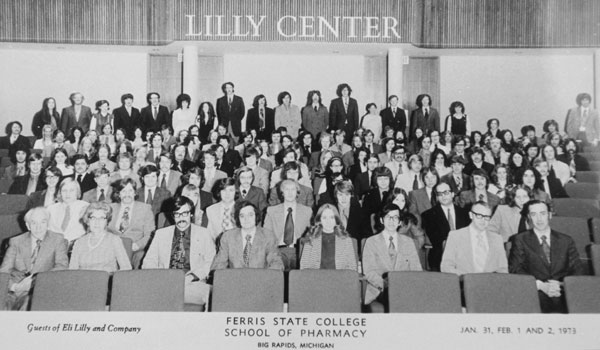
After a delay of several years due to political objectors who felt that the scope for clinical practice was too limited in Big Rapids, the new Pharmacy Building was dedicated in 1972. Dr. Richard Ohvall, School of Pharmacy Dean from 1971-76, presided over the building dedication, and was responsible for initiating the successful decentralized clinical program and a major curriculum revision in 1972. With the departure of Dean Ohvall to Oregon State, Mr. Ron Nickel was appointed acting dean until Dr. Ian Mathison was selected as the dean.
Ian Mathison served as dean of the College of Pharmacy from 1977-2011. Dr. Mathison's interest in pharmacy history resulted in the establishment in 1984 of the Historical Pharmacy, a place honoring the rich heritage of the profession and serving as an appropriate display area for the many gifts from alumni and donors. Also during this period, a detailed study of the Pharm.D. degree and a major curriculum revision of the bachelor s degree resulting in recommendations for an expanded clerkship/externship component and a limited Pharm.D. program were completed. Both of these recommendations were implemented with the first Pharm.D. class being admitted in the fall of 1990. In addition to these changes, a college-wide commitment to research and service activities resulted in the development, by faculty members, of several active research programs both on and off campus, as well as an increase in the number and scope of service activities, particularly by the off-campus faculty. Alumni interest in and support of the College is at an all-time high as evidenced by both financial and professional contributions. Graduates are providing valuable service to the College through active involvement in the alumni board and participation in the College s strategic planning efforts and curriculum revision activities.
Further name changes occurred in 1987 when Ferris State College became Ferris State University and in 1990 when the School of Pharmacy once again became the College of Pharmacy. The College of Pharmacy embarked on its most ambitious programmatic changed in 2000 when the offering of the Doctor of Pharmacy degree as the sole professional degree occurred. This conversion to a four-year professional curriculum with patient care integrated throughout the curriculum necessitated significant curricular changes. The construction of educational facilities in both Grand Rapids and Kalamazoo enabled the third and fourth year students to optimize the application of the didactic curriculum components in patient-care settings. In 2011 Dr. Stephen Durst became dean of the College. Soon after, the new Grand Rapids location was opened bringing together all of the third year students in one location in the 25 Michigan building located in what is known as the Medical Mile. Ferris students are able to interact with a diverse group of medical disciplines be being in the heart of one of the most dynamic medical communities in the region.
Today, the Ferris State University College of Pharmacy is justly proud of the achievements of the past. Ferris has established and maintained a reputation for quality and competence through the performance of its graduates. The many and varied positions of responsibility in industry, education, community, and institutional pharmacy, now being occupied by Ferris Pharmacy graduates clearly attest to the College's continuing interest in the various facets of the profession and the quality of its educational program.

Pharmacy in the 21 st Century
Ferris State University continues to have the largest College of Pharmacy of the three in Michigan and graduates consistently have 97-100% national board exam pass rates and are consistently above the national pass rate.
The pharmacy program at Ferris has enjoyed an exceptional reputation both within the state and throughout the nation for over a century. Our graduates have distinguished themselves throughout the pharmacy profession by their intellectual and professional diligence as a result of the practice emphasis of our curriculum.
Portions of this History section are from an article in the 1965 Michigan Pharmacist written by LeRoy D. Beltz, former professor of Pharmacy.
